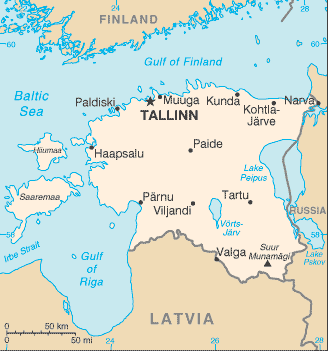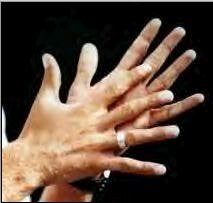Deaf cultures and Sign Languages of the world: Estonia (Eesti)
Created 10 April 2000, links updated monthly with the help of LinkAlarm.
 David Bar-Tzur
David Bar-Tzur

Flag: World flag database.
Map: Maps.com - "search" for country, then "Digital Map Graphics"). OR
Map: Perry-Castañeda Library Map Collection.
For a quick, interesting resource for facts about this and other countries,
try Mystic Planet - The New Age directory of Planet Earth.
Note: Flag next to a link shows what language the website is in. This is sometimes obvious by what country the link is for or the fact that the title is in English. If I feel it may be ambiguous, I have tried to clarify by using a flag. This is done so that people can read sites in the language of their choice. If a flag is followed by this icon:  , there is an animated text in that country's sign language or signs are illustrated. If a globe is followed by this icon, there is an animated text in International Gesture:
, there is an animated text in that country's sign language or signs are illustrated. If a globe is followed by this icon, there is an animated text in International Gesture: 

 Eesti Kuulmispuuetega Laste Vanemate Liit - Implantaadilaste selts. Pealtnäha ei erine kurt laps kuidagi kuuljast lapsest ning tema titaea üldine areng kulgeb samamoodi nagu kõigil teistelgi. Kahtlused ja mure tekivad vanematel tavaliselt siis, kui on aru saada, et lapse kõne ei arene. Kuidas oma kurti last aidata? Kuidas teda suhtlema õpetada? Kaasaegsed kuulmisabivahendid, ka kuuldeaparaadid on üha täiuslikumad. Ometi ei ole kõigil kurtidel nendest piisavat abi kõne kuulmiseks ja omandamiseks. Sellistel juhtudel tuleb abivahendina kõne alla sisekõrva implantaat. Mis see implantaat on? Kellel sellest abi on? Kes on meie lapsed? Mida selle kohta kirjutatud on? Loe meie kodulehelt - tere tulemast!
Eesti Kuulmispuuetega Laste Vanemate Liit - Implantaadilaste selts. Pealtnäha ei erine kurt laps kuidagi kuuljast lapsest ning tema titaea üldine areng kulgeb samamoodi nagu kõigil teistelgi. Kahtlused ja mure tekivad vanematel tavaliselt siis, kui on aru saada, et lapse kõne ei arene. Kuidas oma kurti last aidata? Kuidas teda suhtlema õpetada? Kaasaegsed kuulmisabivahendid, ka kuuldeaparaadid on üha täiuslikumad. Ometi ei ole kõigil kurtidel nendest piisavat abi kõne kuulmiseks ja omandamiseks. Sellistel juhtudel tuleb abivahendina kõne alla sisekõrva implantaat. Mis see implantaat on? Kellel sellest abi on? Kes on meie lapsed? Mida selle kohta kirjutatud on? Loe meie kodulehelt - tere tulemast!
 Paales, L. Estonian deaf biographies. The making of studies. The aim of this article is to analyse the prerequisites and possibilities of studying the life stories of the Estonian deaf. The term 'biography' will be treated in a broader sense, meaning different types of biographical material (reminiscences, narratives about biographical incidences, fragments, etc.). In the article I handle selected texts published in written media between the years 1935-1996.
Paales, L. Estonian deaf biographies. The making of studies. The aim of this article is to analyse the prerequisites and possibilities of studying the life stories of the Estonian deaf. The term 'biography' will be treated in a broader sense, meaning different types of biographical material (reminiscences, narratives about biographical incidences, fragments, etc.). In the article I handle selected texts published in written media between the years 1935-1996.
 Eesti Kurtide Noorte Organisatsioon - Estonian Deaf Organization for Youth.
Eesti Kurtide Noorte Organisatsioon - Estonian Deaf Organization for Youth.
 Eesti Kurtide Spordiliit.
Eesti Kurtide Spordiliit.
 Estonian Sign Language.
Estonian Sign Language.
 Estonian Sign Language: A language of Estonia.
Estonian Sign Language: A language of Estonia.
 -->International bibliography of sign language. --> Click on "E", then on "Estonian Sign Language".
-->International bibliography of sign language. --> Click on "E", then on "Estonian Sign Language".
 Laiapea,, V. (2007). -->Keel on lahti : tähendusi viipekeelest. Tallinn : Eesti Keele Sihtasutus - 127 + 1 DVD p.: ISBN: 978-9985-79179-0*Buch978-9985-79180-6*DVD. -->
Laiapea,, V. (2007). -->Keel on lahti : tähendusi viipekeelest. Tallinn : Eesti Keele Sihtasutus - 127 + 1 DVD p.: ISBN: 978-9985-79179-0*Buch978-9985-79180-6*DVD. -->
 Miljan, M.
Miljan, M.
 Paales, L.
Paales, L.
 (2006). -->Gebärdensprachfolklore in Estland: Einblicke einer Hörenden. In: Das Zeichen 20: 74 - pp. 376-388. -->
(2006). -->Gebärdensprachfolklore in Estland: Einblicke einer Hörenden. In: Das Zeichen 20: 74 - pp. 376-388. -->
 (2004). -->Isikumärkide süsteemist eesti viipekeeles. [Über das System der Zeichen für Personennamen in der estnischen Zeichensprache]. In: Keel ja Kirjandus (KjK) 47: 3 - pp. 201-208. -->
(2004). -->Isikumärkide süsteemist eesti viipekeeles. [Über das System der Zeichen für Personennamen in der estnischen Zeichensprache]. In: Keel ja Kirjandus (KjK) 47: 3 - pp. 201-208. -->
 (2002). -->Isiku- ja kohamärgid Eesti kurtide märgipärimuses. [Name Signs for persons and places in Estonian Deaf Folklore]. In: Oras, Janika (ed): Mall Hiiemäe. Kanni Labi. Lemmeleht. Pro folkloristica IX. Tartu : Eesti Kirjandusmuuseum - pp. 154-167. -->
(2002). -->Isiku- ja kohamärgid Eesti kurtide märgipärimuses. [Name Signs for persons and places in Estonian Deaf Folklore]. In: Oras, Janika (ed): Mall Hiiemäe. Kanni Labi. Lemmeleht. Pro folkloristica IX. Tartu : Eesti Kirjandusmuuseum - pp. 154-167. -->
 A HEARER’S INSIGHT INTO DEAF SIGN LANGUAGE FOLKLORE. The article discusses Estonian deaf lore, which comprises all folklore genres including specific language creation or sign lore characteristic of the deaf. Hearers’ lore has also exerted its influence on deaf lore. Local deaf lore includes memories of school years and family lore of members of the Estonian deaf community, sign lore based on Estonian sign language, etc. The main features of Estonian deaf lore are (i) the specific communicative form, i.e. sign language performance; (ii) the minority group of lore transmitters, i.e. the Estonian deaf community; (iii) group-centred interpretation of hearing loss.
A HEARER’S INSIGHT INTO DEAF SIGN LANGUAGE FOLKLORE. The article discusses Estonian deaf lore, which comprises all folklore genres including specific language creation or sign lore characteristic of the deaf. Hearers’ lore has also exerted its influence on deaf lore. Local deaf lore includes memories of school years and family lore of members of the Estonian deaf community, sign lore based on Estonian sign language, etc. The main features of Estonian deaf lore are (i) the specific communicative form, i.e. sign language performance; (ii) the minority group of lore transmitters, i.e. the Estonian deaf community; (iii) group-centred interpretation of hearing loss.
 Toom, R. Estonian Sign Language yesterday, today, tomorrow. In: Erting, Carol J. et al (eds): The deaf way : perspectives from the International Conference on Deaf Culture. Washington, DC : Gallaudet Univ. Press (1994) - pp. 379-381
Toom, R. Estonian Sign Language yesterday, today, tomorrow. In: Erting, Carol J. et al (eds): The deaf way : perspectives from the International Conference on Deaf Culture. Washington, DC : Gallaudet Univ. Press (1994) - pp. 379-381
 -->International bibliography of sign language. --> Click on "E", then on "Estonian Sign Language dictionary".
-->International bibliography of sign language. --> Click on "E", then on "Estonian Sign Language dictionary".
 Toom, K.
Toom, K.
 Tartu Ülikool. Bachelor’s and Master’s Degree Programs. This lists "Estonian Sign Language interpreter".
Tartu Ülikool. Bachelor’s and Master’s Degree Programs. This lists "Estonian Sign Language interpreter".
 Kutsekoda.
Kutsekoda. ,
, ,
, The Estonian Qualification Authority (trademark - Kutsekoda) was established in August 2001 in order to continue developing the professional qualifications system launched by the Estonian Chamber of Commerce and Industry in 1997. The Professions Chamber was established by the Estonian Chamber of Commerce and Industry, Estonian Employers' Confederation, Ministry of Social Affairs, Estonian Employees' Unions' Confederation (TALO) and the Confederation of Estonian Trade Unions. In addition to the founders of the Professions Chamber, the Supervisory Board of the Professions Chamber includes a representative of the Ministry of Education.
The Estonian Qualification Authority (trademark - Kutsekoda) was established in August 2001 in order to continue developing the professional qualifications system launched by the Estonian Chamber of Commerce and Industry in 1997. The Professions Chamber was established by the Estonian Chamber of Commerce and Industry, Estonian Employers' Confederation, Ministry of Social Affairs, Estonian Employees' Unions' Confederation (TALO) and the Confederation of Estonian Trade Unions. In addition to the founders of the Professions Chamber, the Supervisory Board of the Professions Chamber includes a representative of the Ministry of Education.
 Eesti Viipekeel Tõlkide Ühing - Estonian Association of Sign Language Interpreters.
Eesti Viipekeel Tõlkide Ühing - Estonian Association of Sign Language Interpreters. ,
,
 Estonian Association of Translators and Interpreters.
Estonian Association of Translators and Interpreters. ,
, ,
, ,
, ,
, ,
, ,
, ,
, ,
, ,
,
 Trükmann, M.; Toom, R.; Hollman, L. Eesti viipekeele transkriptsioonist. Estonian Sign Language Transcription, Estonian Papers in Applied Linguistics (2/2006), 285-302. Summary: Estonian Sign Language (ESL) is the native language for approximately 1,500 Estonian Deaf people. Like other sign languages, ESL has no written form. In the history of ESL research, different transcription systems have been used. The system introduced here is based on the one used at the University of Tartu. The structure of the transcription system follows the example of W. Stokoe’s notation system and its expansions. Cherems of Estonian Sign Language are introduced and symbols for 38 hand forms, 26 locations, and 26 different movements are presented. All symbols are easy to use with any computer program. For the detailed transcription of the signs, the symbols for the palm and finger orientation as well as the relationship between the two hands are given. Finally there is provided an overview of the sign language glossing rules which are used in different sign language researches and which form a basis for glossing sign language grammar and semantics.
Trükmann, M.; Toom, R.; Hollman, L. Eesti viipekeele transkriptsioonist. Estonian Sign Language Transcription, Estonian Papers in Applied Linguistics (2/2006), 285-302. Summary: Estonian Sign Language (ESL) is the native language for approximately 1,500 Estonian Deaf people. Like other sign languages, ESL has no written form. In the history of ESL research, different transcription systems have been used. The system introduced here is based on the one used at the University of Tartu. The structure of the transcription system follows the example of W. Stokoe’s notation system and its expansions. Cherems of Estonian Sign Language are introduced and symbols for 38 hand forms, 26 locations, and 26 different movements are presented. All symbols are easy to use with any computer program. For the detailed transcription of the signs, the symbols for the palm and finger orientation as well as the relationship between the two hands are given. Finally there is provided an overview of the sign language glossing rules which are used in different sign language researches and which form a basis for glossing sign language grammar and semantics.
 Eesti Kurtide Liit.
Eesti Kurtide Liit. ,
,
 Eesti Kurtide Noorte Organisatsioon - Estonian Deaf Organization for Youth.
Eesti Kurtide Noorte Organisatsioon - Estonian Deaf Organization for Youth.
 Eesti Kristlik Nelipühi Kirik :: Worldwide Assemblies of God Deaf Conference in Tallinn.
Eesti Kristlik Nelipühi Kirik :: Worldwide Assemblies of God Deaf Conference in Tallinn.

Home
![]() David Bar-Tzur
David Bar-Tzur![]()


